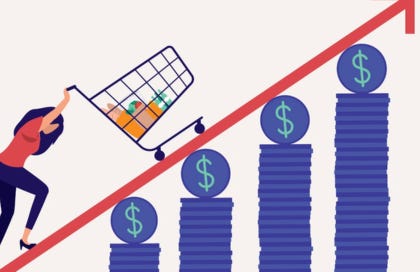This is Jon Donenberg, Staff Director for the Senate Banking, Housing, and Urban Affairs Committee – Democrats. Today, Americans woke up to the news that Donald Trump shrunk our economy over the first three months of the year - and raised the cost of their groceries. Senator Warren captured this well in her statement this morning:
“100 days into his presidency, Donald Trump’s red-light, green-light tariffs are slowing our economy dramatically, with businesses stockpiling imports in anticipation of tariff doomsday. Consumer confidence has consistently plummeted through Trump's first 100 days, and dropped to its lowest point since May 2020 – as Americans are deeply pessimistic about surviving a cratering economy deliberately damaged by the President. Today, Senators Ron Wyden, Rand Paul, and I will force a vote to turn off Trump’s tariffs emergency. Republicans in Congress will have to answer whether they will stand up for their constituents or clear the way for Trump’s tariff chaos to potentially push us into a recession that would shrink the economy and bring widespread job losses, while pushing prices for essential goods even higher.” – Senator Warren
Donald Trump wants to pretend that he’s succeeded in bringing grocery prices down like he promised. But new data today shows he’s shrinking the economy and raising the cost of your groceries—all in under 100 days. – Senator Warren
Let’s dig into the data:
I. GDP
Source: Bureau of Economic Analysis via Bloomberg
The U.S. economy contracted by 0.3% in Q1 2025. This downturn was triggered by a surge in imports that severely undermined net exports, as businesses frantically stockpile foreign goods ahead of impending tariffs. Corporate leaders are bracing for the inevitable supply chain disruptions and skyrocketing input costs that will result from the administration's sweeping, across-the-board tariffs. The data unmistakably reveals that the Trump administration's erratic trade policies have directly precipitated this economic decline. Collapsing business confidence and paralyzing market uncertainty drove this alarming economic reversal.
Additionally, “final sales to domestic purchasers” – which measures the total spending by U.S. consumers, businesses, and government, excluding inventory changes and exports – grew 2.3% in the first quarter, compared to 3% in the final quarter of 2024. Even without factoring in imports, the economy still showed signs of slowing. This is likely due to consumer spending, which showed deceleration in Q1 despite reports of consumers also stocking up ahead of tariff announcements. Consumer spending grew 1.8% in the first quarter, down from 4% at the end of 2024. While it came in higher than forecasted, this cooling in consumption is notable and coincides with five consecutive months of declining consumer confidence—a pattern not seen since the 2008 financial crisis—raising additional concerns about the economic outlook for the remainder of 2025. Some analysts have warned that these figures also reflect a boost in domestic demand that reflects companies and individuals trying to get ahead of the tariffs, which could constrain future growth.
II. Costs
Source: Bureau of Economic Analysis
Today's PCE report indicated cooling inflation in March, with both headline and core inflation remaining flat month-over-month. However, food prices rose from 1.5% to 2% year-over-year, contradicting President Trump’s claims about lowering grocery costs during his first 100 days in office. This is in line with March CPI data, which showed that grocery prices (as indicated by “food at home”) increased nearly 0.5% in March, and was up 2.4% compared to the prior year.
Moreover, inflation data in today’s GDP report showed concerning increases, with Q1 PCE inflation rising to 3.6% annualized in Q1 (3.5% core), up from 2.4% in Q4 2024. The chain-weighted price index, another measure of inflation that accounts for consumer behavior and substitution effects, grew 3.7% – well above its 3% forecast – suggesting that consumers must spend more to maintain their standard of living.
III. Jobs
Finally, the employment situation also continues to raise concerns. Today’s ADP National Employment Report shows that private employers added 62,000 jobs in April, well below the 120,000 forecast and down from 147,000 in March. ADP’s chief economist summarized this deceleration in hiring, calling “unease…the word of the day” and noting that “employers are trying to reconcile policy and consumer uncertainty with a run of mostly positive economic data.” This report comes ahead of this Friday’s Bureau of Labor Statistics’ March jobs report, where forecasters expect steady job growth and an unchanged unemployment rate. However, the ADP figures suggest a more cautious hiring climate that – if sustained – could lead to a weaker labor market.





